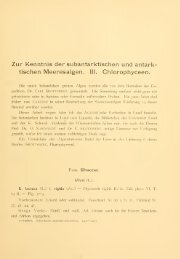Download PDF
Download PDF
Download PDF
You also want an ePaper? Increase the reach of your titles
YUMPU automatically turns print PDFs into web optimized ePapers that Google loves.
TAXONOMIC CHARACTERISTICS 9<br />
gametic segregates. In the few instances in which such progeny<br />
have been studied, individual filaments inherit the factor for cell<br />
diameters, forms of receptive gametangia, zygospore size, form,<br />
and wall markings independently. They are expressed through<br />
the cytoplasm of the female gametes. So long as these segregates<br />
reproduce by cell division, by akinetes, by aplanospores, and by<br />
conjugation between cells of the same haploid filament, the gene<br />
complex of the progeny is identical and the filaments are uniform.<br />
Doubtless many of the "species" that are collected and named are<br />
taxonomic units, or clones, that have originated in this way. Other<br />
species seem to have originated by polyploidy and by mutation,<br />
but the evidence for this statement is purely circumstantial.<br />
The bases for the separation of the genera are shown in<br />
the following key. Three genera (Hallasia, Pletirodiscus, and<br />
Entransia) are tentatively and purposely defined to emphasize<br />
the need for further study of the development and reproduction<br />
of these species. All the forms described in this key are designated<br />
as "species." Many variations have been seen in the collections<br />
studied but until more is known about hybrid segregates, isolated<br />
clones, and the effects of the various environmental factors, it<br />
seems unprofitable to assign "variety" and "form" names to every<br />
variant. Many alleged "varieties" are not even closely related to<br />
the species to which they have been assigned.<br />
Key to the Genera of ZYGNEMATACEAE<br />
I. Vegetative cells usually with 2 axile chromatophores, which are<br />
round, radially branched, pillow-shaped, or disclike, with nucleus<br />
contained in the cytoplasmic bridge between them<br />
I. Chromatophores usually a pair of axile stellate or globose radi-<br />
ally symmetric bodies, each with a central pyrenoid<br />
a) Zygospores compressed-globose or ovoid in the tubes or in<br />
one of the gametangia; aplanospores cylindric-ovoid occupy-<br />
ing all or most of the cell; gametangia not filled with a<br />
dense refractive colloid after conjugation, and without cytoplasmic<br />
residues i. Zygnema<br />
b) Zygospores quadrangular-ovoid, or round pillow-shaped,<br />
formed in the extremely wide but shallow conjugating tubes;<br />
aplanospores ellipsoid or asymmetrically ovoid; successive<br />
layers of cellulose and pectic colloids added inside the gam-<br />
etangial walls during conjugation; similar changes occur in




